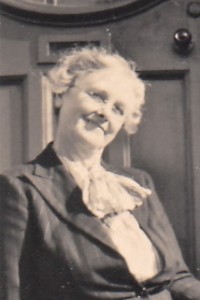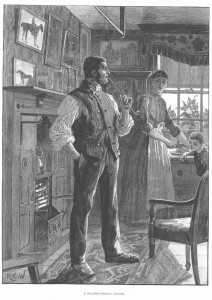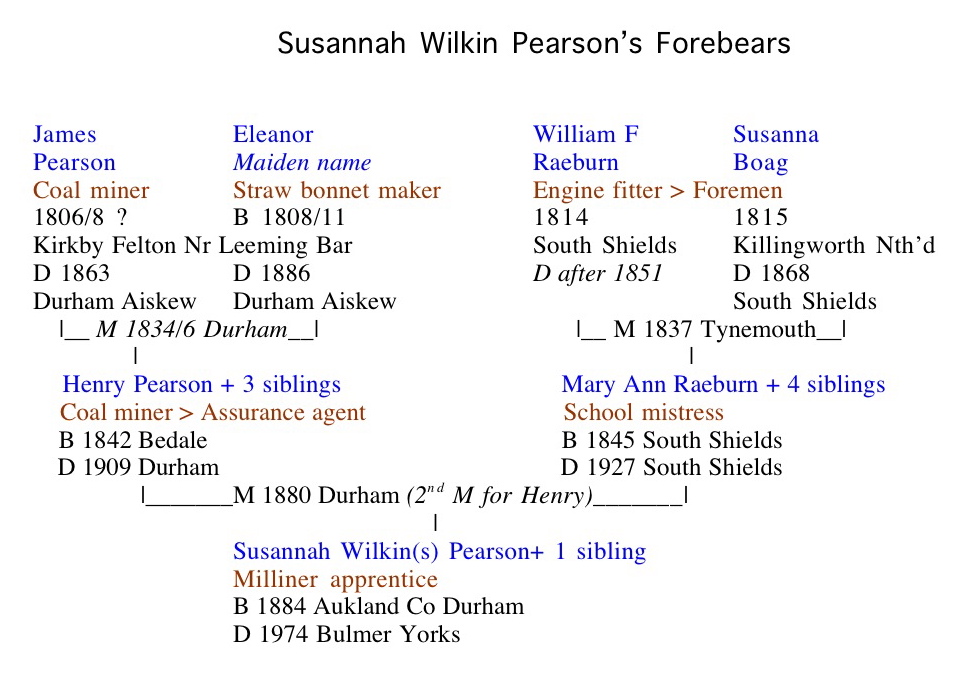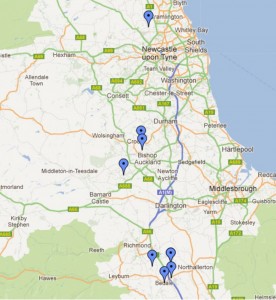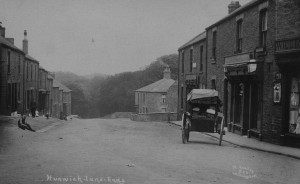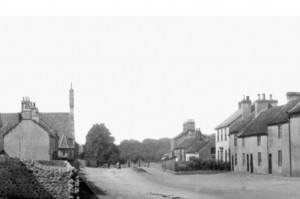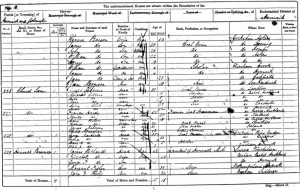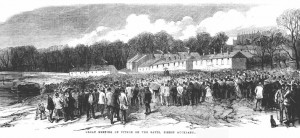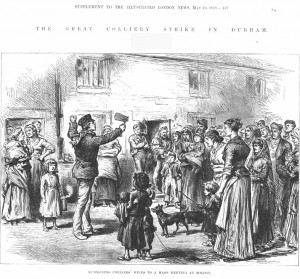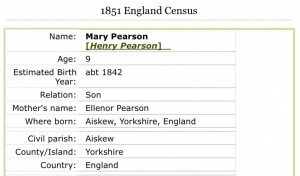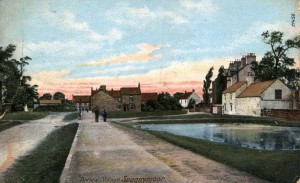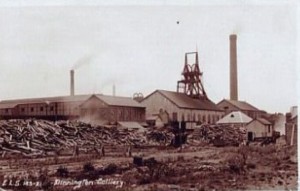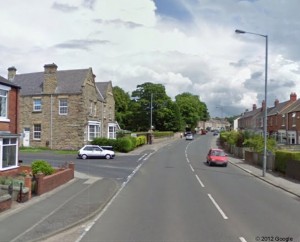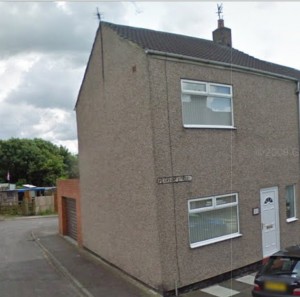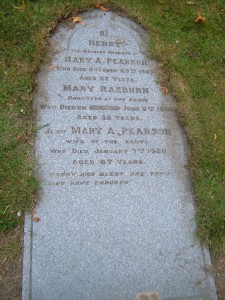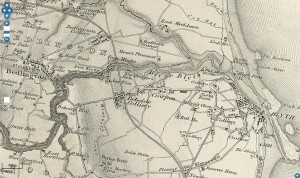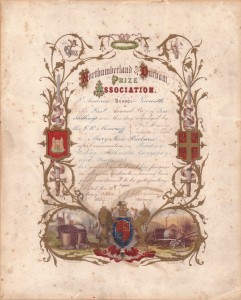Pearsons and Raeburns
The Forebears of Susannah Wilkin Pearson
If there was one forebear in the McNamara family, known to her grandchildren, who was conscious of her family heritage, her standing in society and the need to observe social proprieties and maintain the highest standards of behaviour it was our paternal grandmother, Susannah* Wilkin Pearson, Nana. Nana was descended from two families, the Pearsons and the Raeburns. It may surprise those who were acquainted with her to know that she was the daughter of a coal miner and descended from colliers on both sides of her family.
* On some records spelt without the ‘h’.
The Pearsons
It is difficult to trace the roots of the Peason line. However, the first ancestral Pearson that I can identify with a reasonable degree of confidence is William Pearson who was born in 1750. Nothing more is known about him except that he had a son named James Pearson who was born in 1777 and who died in 1865. He married Ann Robinson, 1770 – 1844. I have no further details of this couple but they did have a son, another James Pearson, born in 1808 at Kirkby Fleetham (there are alternative spellings for this place name, for example see above) which is about six miles west of Northallerton (for the locations mentioned in this section, see the map below).
This Pearson, who was the grandfather of Susannah Wilkin Pearson, Nana, is the first one about whom there is more substantial evidence and he first appears on the documented record in 1861 (for the family tree for Susannah’s forebears, see above). It is perhaps significant to observe that the James, who was born in 1808, did not appear on any census record until 1861 when he was 53. One wonders why.
However, before then James’s wife, Eleanor Pearson, was listed on the 1851 Census as living at Aiskew *, Yorkshire with her son William, aged 12, and daughter Mary, aged 9. But there is a mistake on the Census the child was her son, Henry, see below. Her husband, James, was not living in the household and neither were the two elder sons, who will have been of working age. They cannot be traced on the census for 1851. One can only assume that the father and two sons where working away from home in a situation which precluded them from being recorded on the census forms. They may even have been down a local pit at the time when the census was taken. Since there was no breadwinner in the maternal home one assumes that the husband was supporting the family.
* Aiskew is no longer an identifiable village but is now a suburb of Bedale on the A684 to the east of the A1.
The first comprehensive record of the family is provided by the 1861 Census. James Pearson, who was a coal miner, was living at 225 Church Lane, Hunwick and Helmington, Yorkshire. James was married to Eleanor Asquith born in 1808 at Aiskew (but written Asken on the census sheet). The only other information that I can discover about his wife is that Eleanor was the daughter of John Askwith born in 1771 and Ellen Barnett born in 1777. I can vaguely remember Dad talking about ‘The Askwiths’ in a manner suggesting that they added lustre to the family name. No doubt related to Lord Askwith, prime minister 1908 – 1916.
As can be seen from the Census, living in the Pearson household with the father were: Eleanor, his wife; four sons, James, John, William and Henry; a daughter in law, Jane; two grandsons, William and James; and Jane Megginson, a servant.
An obvious observation to make about the family is that it included five miners who were wage earners. The family must have been comparatively well off to be able to keep a servant. The histories and stories of Durham mining communities often suggest that mining families endured lives of comparative hardship, if not poverty. However, our forebears could afford a servant. It should be noted that the term ‘miner’ did not include supervisory roles, such people were usually referred to as mine captains. So it was unlikely that any members of the family had managerial positions. The locations of the dwelling places and birth places of family during its working life indicate that they must have been fairly mobile within the Yorkshire and Durham coal fields. One can only surmise that they had to move to find work or improve their working conditions.
It was also an era of strikes and labour disputes.
Finally, one must note the youngest son, Henry Pearson, who goes on to find his place in history as the father of Nana. Henry Pearson must have been a dominant force in Nana’s life to the extent that Dad had to bear as his two Christian names his grandfather’s full name. James Pearson was to die at that address two years later in 1863. His wife died in the Durham area in 1886.
Henry Pearson was to live a somewhat varied but successful life. The first misfortune I can identify is that he seems to have been incorrectly entered on the 1851 Census as a girl,Mary. The ‘Mary’ entry does seem wrong; there is no other mention of a ‘Mary’ in the family, her birth year was the same as Henry’s and as a nine year old it is hardly likely that she would have been in the care of the Father and elder brothers while a sister remained with the mother. And this is important as far as Susannah’s ancestry is concerned. Fortunately there is a later correction on the census record which changes the name Mary to Henry and this does make more sense. It is important to record this, see below.
After 1861 Henry must have had a difficult life and the available documented information is frustratingly brief. We know that in 1865 at the age of 23 he married Elizabeth who was born about 1839 at Aukland. She was to die four years later in 1869 at Aukland. They had a son William Henry born in 1866 at Billy Row, Durham.
In 1871 Henry, a widower, was recorded as living at 75 Pit Row, Tudhoe with his young son, William Henry, aged five and his mother now aged 63. He was still working as a coal miner.
In 1880, eleven years after the death of his first wife, William married for a second time at Durham. As previously, he wed an older woman, namely Mary Ann Raeburn, Nana’s mother. I feel that in some ways this marriage was a crucial event in the family story and I would like to know more about the couple, how they met and why they married. Mary Ann was a spinster school teacher in her thirties. William, when he met Mary, was a widow in his late thirties living with his son and mother. He was either still working as a miner at the time or had by then become an insurance agent. William must have had some aptitude, education and qualities which enabled him to work his way out of the pit into a non-manual occupation and to be acceptable to a school mistress. I imagine that Nana’s mother would be rather discerning in the selection of her husband. But it may have been that as a spinster in her thirties she was keen to find a partner.
In 1871 Mary Ann had been living and working at Dinnington and there was a coal mine in the village. As the village school teacher Mary would have known many mining families and have been familiar with the life and culture of mining communities. There is no information which could indicate that William visited or worked at the Dinnington mine but I suppose that love among the slag heaps is a remote possibility.
In 1881 Henry was living at 96 Naisbitts Terrace, Tudhoe with his new wife, Mary Ann, and his son by his first wife, William Henry, aged 15. William was an apprentice engine fitter. Also living with them was his mother, Elanor, 73. Henry had left the mine and has become a life assurance agent. When and by what means we do not know. On the census form Mary is described as a former school teacher but this has then been crossed out.
Nana’s half brother, William Henry, died at Durham in 1889.
By 1891 William and Mary Pearson had moved to 65 Durham Road, Tudhoe and William was still described as an insurance agent. They had two children, Mary, aged ,9, and Susannah, aged 7. But interestingly Mary was born in Newcastle. One cannot tell if the family had moved back there for a while or whether Mary had moved back to the North East to be in the care of members of her family. Also registered as living with the family was William Lamsdale, 32, a Baptist Minister who was born in Scotland. This certainly testifies to the strong Baptist tradition in Nana’s family and hints at some connection with Scotland.
Continuing to 1901 Henry and his wife were still living at Durham Road with their Daughter, Susannah, now aged 17, who was described on the census as a milliner apprentice. The job description applied to a person who made and sold hats.
At this time the elder daughter, Mary Raeburn was working as a Board School teacher (for information about Board Schools, see here) and lodged at the home of a coal miner at Bear Park, Durham.
Nana’s father, Henry, died in 1909 at Aukland. In his will he left £852 3s 5p to his wife and two daughters. That is equivalent to £65,800 in terms of the retain price index in 2010 and £347,00 in terms of average earnings today. (Average earnings is considered the better index for making comparisons with current prices.) Not bad for an ex miner. He was probably a man of some standing in the community. There is a Pearson Street in Tudhoe and a web record noting that it is named after Henry.
Susanna’s mother, Mary, lived on to 1927 when she died in South Shields. In 1911 Susanna’s sister. Mary Raeburn, was working as a school teacher and boarding at 37 St Anns Hill, Wandsworth. Mary Raeburn died in 1914 at Wandsworth, London. She died a spinster and in her will left her effects worth £240 4s 6p to her widowed mother. In comparison with 2010 values that is £17,900 in terms of the retail price index and £93,300 in terms of average earnings. At that time a school teacher would have been earning in the region of £60 – 100 per year. So she did leave a considerable sum, possibly some of it will have been inherited from her father.
What it does suggest is that eventually Nana must have eventually inherited a considerable sum in 1927. It is speculation but this will have been about the time when Dad was considering going to medical school and this inheritance may have provided the wherewithal for him to do so.
To conclude this section, I once spent an afternoon with Dad in Spennymoor Tudhoe Cemetery searching for a family grave. He was vague about precisely what he was looking for and did not know where to locate it in a very large cemetery. However, there is a picture of the grave he must have been looking for on the web and it is the grave stone for Nana’s parents and her sister.
The Raeburns
The Raeburn family had its roots in the South Shields region. The first Raeburn linked to the McNamara family that I can trace is Charles Raeburn who was born in 1750 and he married Ann Dow born in 1751. It should be emphasised that this is a correct record because it is important with reference to challenging the Raeburn Myth, see here.There is no further information about them but they had a son, John Raeburn, who was born at South Shields in 1779 and died there in 1855. In 1810 he married Mary Fenwick at Jarrow. She was born in 1787 at Durham, I cannot trace her death. The couple were to have six children the youngest of whom was William Fenwick Raeburn. He was born at South Shields in 1813. In 1837 at Tynemouth he married Susannah Boag, for more information, see here. She was born in 1815 at Northumberland. Presumably Nana takes her name from this Susannah.
William Fenwick and Susannah were included in the first census in 1841. They were both living in what appears (from the information on the census record) to be a lodging house or large dwelling at South Street, Bishop Wearmouth, Sunderland. The abbreviated job description is difficult to read but William was probably a shoe maker. There were more than a dozen other people living in the property. The census record seems irregular since William and Susannah were recorded as separate units and not as a single family. In addition, by 1841 their first child would have been born and there is no record of her on the census. The infant may simply have gone unnoticed.
Ten years later in 1851 the family had moved and become well established. William aged 37 was a boilermaker. He was the head of the family and they lived at Bedlington which is five miles inland from Blyth, north of Newcastle. They had five children, namely: Elizabeth ,15, born at Benton, Northumberland; Mary Ann, 8, born at South Shields; Susannah, 6, born at Bedlington; William, 4, born at Bedlington; and Hannah, 10 months, born at Bedlington. These dates and birthplaces suggest that William improved his position and moved to Bedlington about 1845. Also living in what must have been for the time a substantial household were five lodgers aged between 18 and 28, three engineers, a blacksmith and a farm labourer. The industry in which William was most likely working was ship building.
When I was given the Waterhouse documents I was also given a prize certificate for Mary Ann Raeburn. It is a rather splendid coloured engraving. It was awarded to her in 1859 when she was 14 years old and attending Dr Andrews School, Newcastle. Presumably it was given to her at about the time she left school to become a pupil teacher. It does enable one to date the next family move to Newcastle as being before 1859.
On the 1861 Census William Fenwick’s family is listed as living at Lindale Street, Westgate, Newcastle upon Tyne. William had become an engine fitter. The children were all still living with the family and all except the youngest were working. Elizabeth, 23, was a dress maker, Mary Ann, 17, was a pupil teacher, Susannah was a dress maker and William, 13, was a solicitor’s clerk, Hannah, 10, was still at school. William Fenwick probably died at Newcastle in 1870 aged 56 and his wife, Susannah died at South Shields in 1868 aged 53. The key member of the family for the McNamaras is the young, unsuspecting pupil teacher, Mary Ann, who was to become Nana’s mother.
By 1871 Mary Ann aged 27 was a spinster school teacher living alone at the village of Dinnington which is located about ten miles north of Newcastle and half a mile north of what is now the runway for Newcastle Airport. Why she decided to move there one cannot say. However by a stroke of luck (I literally pressed the wrong key) I discovered that in the mid 1800s there was a farming family of Fenwicks living in Dinnington so she may have had some family connection with the village.
As recounted above, Mary became the wife of Henry Pearson the mother of Nana.

